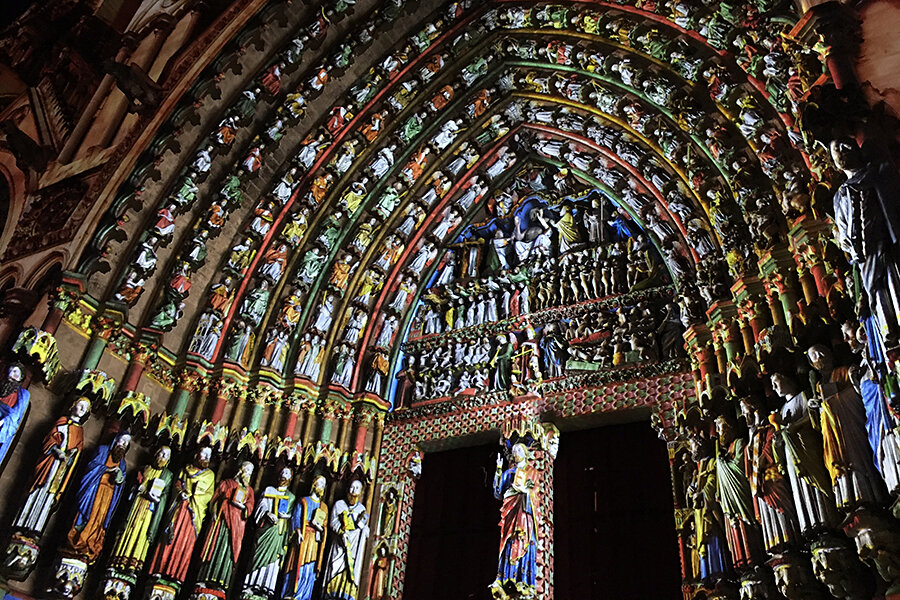Why 'son et lumiere' shows light up French summer nights
Loading...
| Amiens, France
I was feeling slightly wistful about our family missing the Fourth of July in the US – until the following weekend when we found ourselves in front of the cathedral of Amiens at nightfall, watching its facade splashed in color, the light show giving the sense that the Gothic cathedral, unmoved since the 13th century, was dancing before us.
Forget fireworks, we had son et lumiere.
While the French are old hands at the artform, I had the feeling we were experiencing the show “Chroma” the way spectators did in 1952, when Paul Robert-Houdin officially introduced them to a brand new genre. The architect and curator, fittingly also the grandson of a famous French magician, projected special lights, set to accompanied sound, onto the facade of the Chateau de Chambord, a Renaissance castle in the Loire Valley, playing with spectators’ sense of place and emotion.
The late French public official Jacques Rigaud was sent to Chambord to observe those rehearsals and premiere, and recalled beholding his first son et lumiere with a sense of “wonder.” “We had the feeling that a new way of discovering and understanding monumental heritage was perhaps being born,” he wrote in Le Figaro in 2002, in a commemorative piece marking the 50th anniversary of the form, noting that large numbers came to witness the show through the end of that summer of 1952.
In fact, 65 years later, visitors continue to flock to son et lumiere: to watch light shows, often set to historical narratives, projected onto gothic abbeys or baroque monuments, from its birthplace in the Loire Valley, to France at large, and today around the world.
Fireworks have their place in France too, especially during the country's annual independence day fête. Last weekend's Bastille Day, which President Trump attended, looked in many ways like the Fourth of July, save for the Eiffel Tower in the background of the grand feu d’artifice display in Paris. But son et lumiere is, I dare say, that much more mesmerizing.
The art form has evolved over time with technology, with 3D projection mapping and changing cultural sensibilities. Marc Vidal, director of Spectre Lab, which created the Amiens show running through the end of the summer, says that “Chroma” was meant as a new experience for Amiens. The city has put on a light show for over a decade and a half, but the new version was meant to be something less historical, and overall more fun – which explains the punchy music and bursting colors – without forgetting the point of the show.
"It’s not the effects for the sake of effects,” he says. “The animations highlight the building, the architecture ... the pure history of the cathedral.” The final 30 minutes of Chroma are particularly moving, as lighting paints in the ornate sculptures that adorn the cathedral's principal facade, allowing visitors to experience it in polychrome the way it would have looked in the Middle Ages.
Mr. Vidal says the birth of son et lumiere likely owes to the tradition of grand fêtes tracing back to King Louis XIV at Versailles, France’s pioneering in cinema and projection, and its abundance of historic monuments.
Yet it is but a subset of light used as art that’s taken off around the world, including in the US.
Bettina Pelz, a German curator who wrote a chapter on art in the new book “Light beyond 2015,” after the UNESCO International Year of Light, says that light-related projects in the public space have grown in the past 15 years. While usually lumped together, they vary widely in their aesthetics and technical capabilities – not to mention in the visions of curators or local officials and institutions.
Europe remains the heartland of the art. Light shows, like the famous Festival of Lights in Lyon, have inspired many others. Such shows are common in northern Europe as the winter solstice nears. Many Asian projects today link with European initiatives, says Ms. Pelz.
“Light is exciting to the eye,” Pelz says. “We can detect the changes caused by light but light itself remains invisible. This interplay of visible-invisible is quite stimulating.... Light-based works play with the appearance and disappearance of space, with the change of position and perspective, as well with the performative qualities of color and shape. They stage the inextricable link between the image and its perception. Instead of observing an artwork, the viewer is experiencing it. Viewing and imaging become entangled processes.”






